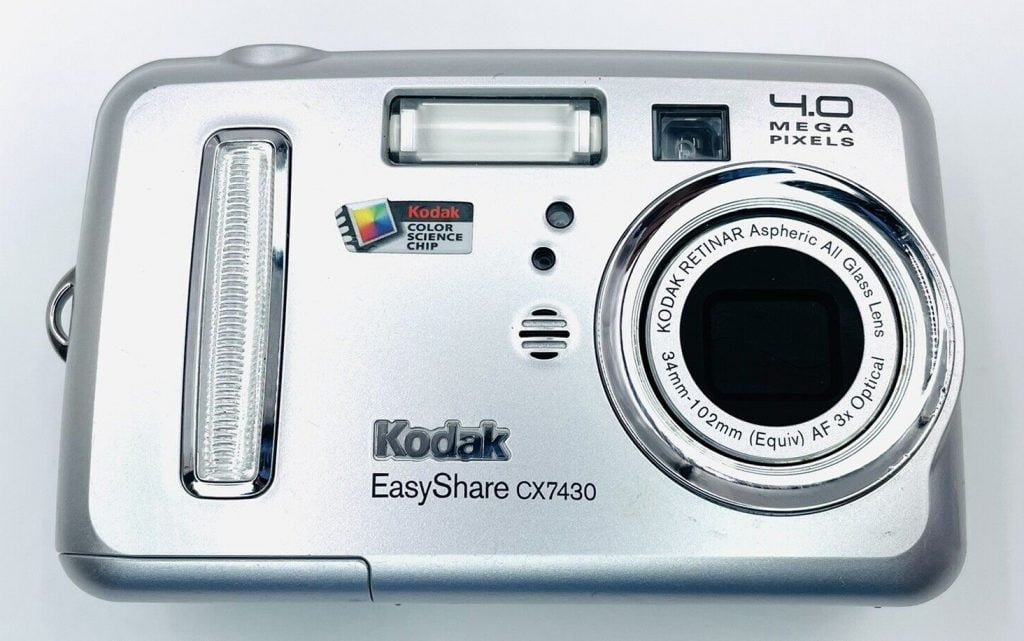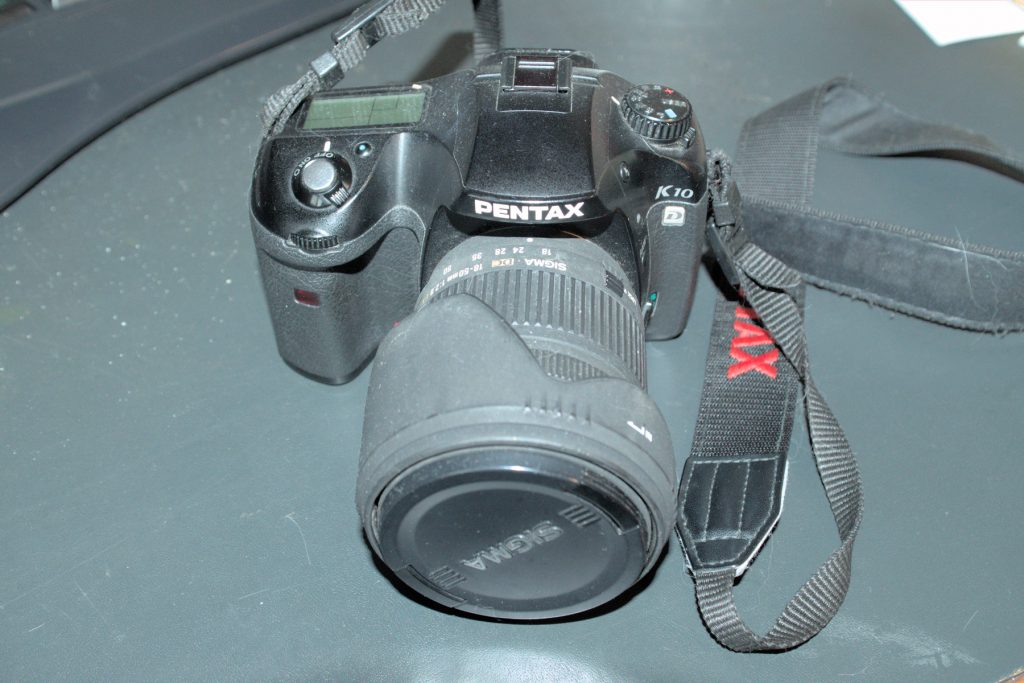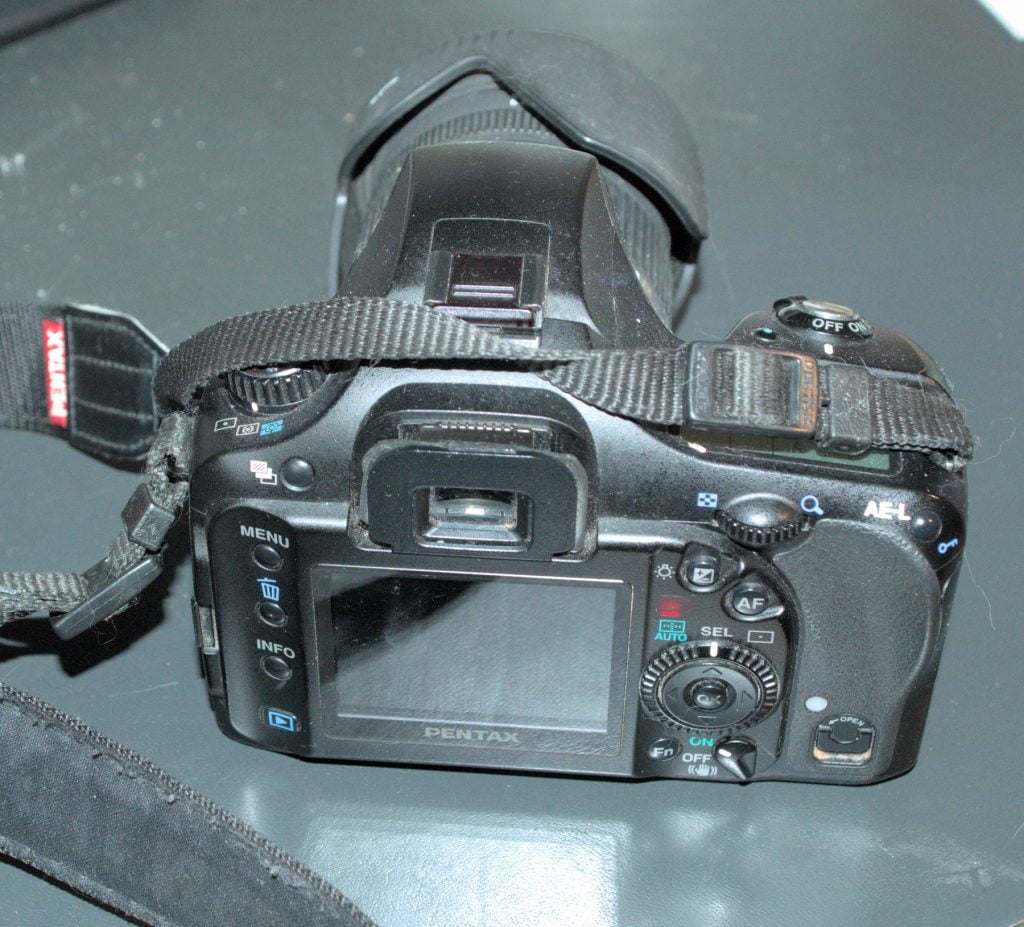The Digital Era (early)
The great thing about the digital cameras – at least for people like me who are fascinated with the numbers – is that I have a quick and easy way to count how many images I have, and in the most part can tell roughly how many images in total the camera had taken at that point in time, due to the in-camera image numbering schemes that every digital camera I’ve ever used has. Images from the first camera were not reliably stored with their image number so it is hard to determine what has been lost, but every camera apart from that one has stored images with sequential numbering.
Kodak CX7430 point-and-shoot
My first step into digital photography was a small one. My ex- and I bought a Kodak point-and-shoot – a Kodak CX7430. Amazingly enough, you can still buy refurbished versions of this camera on EBay and Amazon (for less that $20, in the most part). I honestly think you’d be wasting your money, even so. It wasn’t a bad camera for its time, but it wasn’t fantastic either and its time was nearly 20 years ago.

I’m not sure what has happened to this camera. It hung around for many years, but it does not appear to be in my possession anymore. It might be at the ex’s house. It was a 4 Mpixel thing, and we bought it, if I’m remembering correctly, because we wanted a simple and transportable camera for taking holiday and family snaps that didn’t need film. Released in 2004, we appear to have bought ours in late December 2004, as the first photo was taken at a New Years Eve party that year.
I have images up to June 2008 and then the next image isn’t until 2010. The image naming was a bit haphazard, with images before 2008 not being stored with their sequence number. A few in 2008 were, and then it went back to random naming until the last few, which were taken in December 2011, where the camera’s sequence number is in the low 3000’s. I have just under 2000 images from this camera in the image store, so clearly about 1,000 are missing. I had a disk failure at one point and I recovered things from a backup copy on a different hard disk, but I know now that wasn’t complete. I managed to recover some of the missing files from an earlier DVD backup I had taken, but since I know that backup did not contain everything it should have either (see below), it seems likely other things got lost too.
Pentax K10-D DSLR
In February 2008 I bought my first ever digital SLR. It is a 10 Mpixel APS-C sensor Pentax K10D digital SLR. As with any digital SLR, it is auto-everything. Like the MZ-50 camera, it comes with inbuilt pop-up flash unit. I have only ever had one battery pack for this camera, and 14 years later it still holds charge well enough for several hours of moderate usage. I don’t remember why I decided on the Pentax, but I suspect my prior history with the Pentax brand and having lenses that were at least theoretically compatible with the camera probably helped. As at the date of writing (December 2022), this camera was last used in October 2022.

It came (I believe) with a Sigma kit lens – a Sigma 18 – 50mm f2.8 EX DC. This lens is still in use, although it is a little the worse for wear these days. Sometimes, while the camera is trying to autofocus, the lens makes a bit of a grumbly noise and doesn’t move for a second or two. I’m envisaging that internally gears are spinning for a bit until they manage to grip properly.The external focus ring is hard connected to the focus motors, and if the lens isn’t switched to manual focus on the lens, turning the focus ring forces internal bits to move that are trying hard not to move. This camera has been used by the kids pretty much exclusively for the last 8 years, and I suspect at some point someone (and I’m not saying I know who) has tried to move the focus ring manually while it is switched to autofocus mode, or (probably more likely) has accidentally held the focus ring and stopped it moving while the camera is trying to autofocus. The result is that I suspect some internal components have become a bit more worn than ideal. That and a combination of wear from use, most likely. I have other lenses that can fit this camera that provide similar range, so it isn’t the end of the world if the lens dies, but it was a good lens for its time and takes decent photos (for a 10Mpixel camera, anyway).
I have a number of other Pentax KAF-mount lenses that would work on this camera, as it uses the same mount as for the K-S2 camera that will appear in the next blog. I will discuss those lenses with that camera since that is where they see more use.
This is the first of the cameras that is still in occasional use. It doesn’t get much use these days, but it does come out on occasion when both son and daughter are out on a shoot with me. My daughter was very happy when I bought the newest camera, because it meant I had three SLR(-ish) cameras and this camera was then available for her to use when all three of us were out. And it has been an amazing workhorse.

According to the camera, it has taken 25,967 photographs in its life. There are 23,549 in my image library, so it seems about 2,400 photos from this camera have gone missing as well, which is annoying. About 1,600 of those are from the second half of a European trip we did in 2008. As an aside, 800 missing out of 26,000 is 3% which is probably mostly accounted for by photos that were so bad they were deleted before downloading, and videos.
I normally store raw photos and convert on the PC – but for the European trip I didn’t have enough SD cards to store six weeks worth of photos. So for that trip I had the camera storing just the converted JPG files instead. At some point after I had copied the files onto the PC, I discovered that the disk-to-disk backup processes were not expecting JPG originals and so for a period there, the JPG files were not being backed up. Of course, I discovered this after a hard disk failure, which is how some appear to have been lost. I was able to recover most of the lost files for this and the Kodak above from an earlier backup I’d written to DVD. I cannot explain why the DVD backup I had only had half of the pictures from that European trip though. It was built through the simple expedient of just copying the entire directory structure to disk, so should have contained everything… but clearly didn’t.
An interesting quirk which I cannot explain is the lens used for the photos I do have from that European trip. Those photos report in their EXIF data that they were taken with a Tamron 35-90mm f4 lens. I have nothing matching that in any of the three camera bags now. I would have suspected it was a glitch with how the lens was reported except that that lens does not appear in the photos taken before the trip (including several which were converted in-camera to JPG), and apart from that trip only appears on two (raw) photos from 2016 (ironically, one of them being a photo of my computer screen when I was deciding to purchase the replacement for this camera). I must have another lens kicking around – I did think I had an autofocus lens from the MZ-50 which does not appear to be in the bag with that camera, so maybe this is my missing lens? It certainly wouldn’t have been an inappropriate range for a full-frame camera.
Leave a Reply